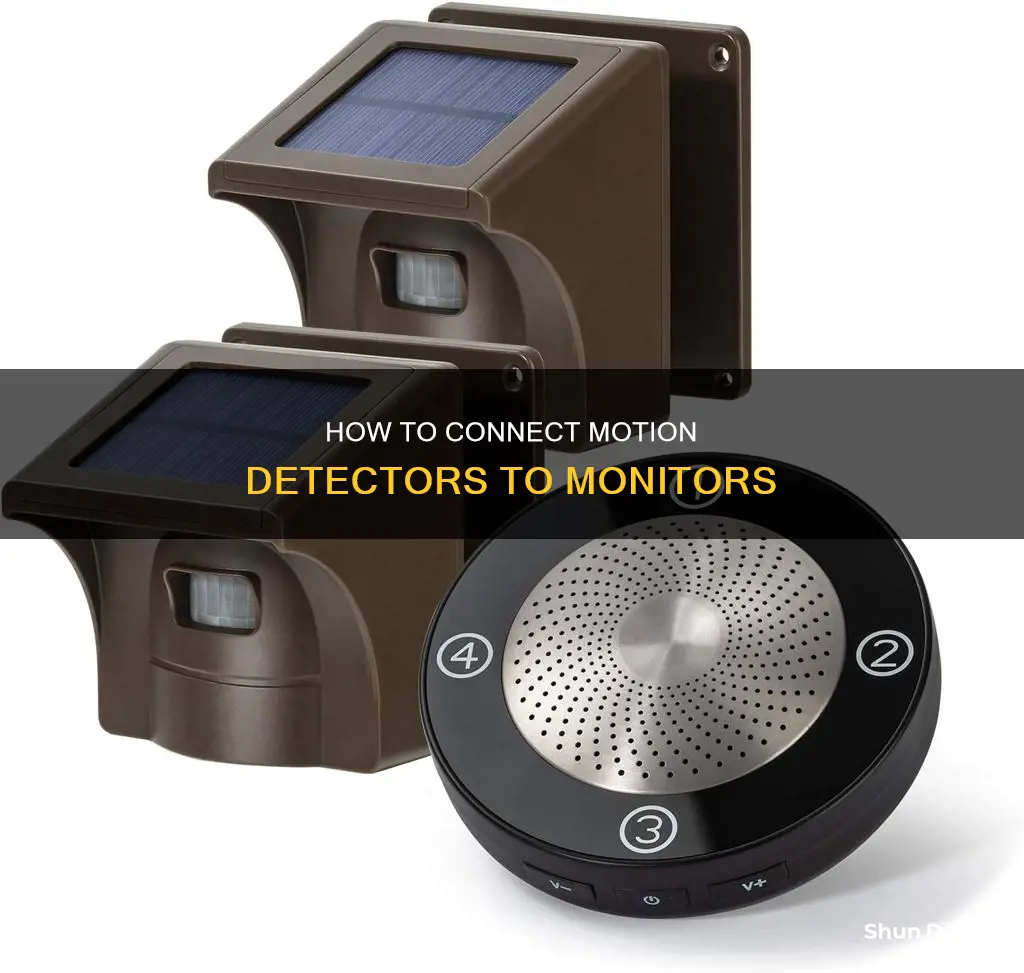
Motion detectors are a vital component of any home security system. They can be hooked up to monitors and are often integrated as a component of a system that automatically performs a task or alerts a user of motion in an area. Motion detectors can be used to trigger a siren or alarm system to ward off unwanted visitors, monitor children or pets, and notify you of guests' arrivals. They can also be used to automate lighting and other smart devices in your home.
| Characteristics | Values |
|---|---|
| Purpose | Security, automated lighting control, home control, energy efficiency |
| Function | Detects movement in an area |
| Alert | Sends a signal to a control panel |
| Distance | Most low-cost motion detectors can detect motion at distances of about 4.6 metres (15 ft) |
| Types | Passive infrared (PIR), microwave, tomographic, vibration, area reflective, ultrasonic |
| Placement | Opposite entry points, narrow points, corners, high on the wall |
| Compatibility | Home security cameras, video doorbells, smart locks, motion sensor lights, door sensors |
| Sensitivity | Adjustable, can be set to ignore movement from creatures under certain weights |
| Price | $30-$50 |
What You'll Learn

Motion detectors and home security
Motion detectors are an essential component of home security systems. They can detect when someone is in your home when they shouldn't be and alert you to a potential threat.
There are several types of motion detectors, each working on a slightly different principle. The two most common types are passive infrared (PIR) sensors and microwave sensors. PIR sensors work by collecting infrared light, which is part of the electromagnetic spectrum that the human eye can't see. The detector contains two separate sensors, each made of a special material that is sensitive to infrared light. One of the sensors reads the ambient temperature of the space being monitored, while the other detects any sudden temperature changes. If there is a difference between what the two sensors detect, a pulse is triggered, signalling movement.
Microwave sensors, on the other hand, constantly send out microwaves that bounce off objects and back to the sensor. The sensor measures the reflection rate, which allows it to know how far away objects are. If anything moves, the change in the reflection rate is registered as motion.
There are also less common types of motion detectors, such as ultrasonic sensors, vibration sensors, and tomographic sensors. Ultrasonic sensors work similarly to microwave sensors but use ultrasonic sound waves instead of microwaves. Vibration sensors detect the small vibrations people make as they walk through a space, while tomographic sensors use several nodes placed throughout a space to detect movement.
When choosing a motion detector for your home security system, it's important to consider compatibility with your existing system, sensitivity levels (especially if you have pets), smart home integration, and the type of sensor. Motion detectors typically cost between $30 and $50.
In addition to home security, motion detectors have a wide range of other applications, including automatic door openers, smart lighting systems, and video game consoles.
Asus VS248: Built-in Speakers or Not?
You may want to see also

Motion detectors and energy efficiency
Motion detectors are an essential component of security systems, but they are also useful for energy efficiency. They can be integrated with home automation systems to connect with other devices for energy optimization.
One of the most common applications of motion detectors is in smart lighting systems. Motion sensors can be used to activate street lights or indoor lights in walkways, such as lobbies and staircases. These sensors ensure that lights are only powered when people are present in a room, reducing energy consumption. This is especially useful in rooms where people tend to leave the lights on.
The Motion Sensor Mini, for example, can be connected to lights, which will then turn on and off when people enter and leave the room. The combination of a PIR sensor and a light sensor means that the lights will only turn on if there is a need for more lighting in the room, further minimizing energy use.
In addition to energy efficiency, motion detectors can also provide safety and convenience. For instance, a motion sensor can be placed in a bathroom to provide light when someone enters at night. Motion detection technology can also be used for security purposes, triggering an alarm when movement is detected.
Overall, motion detectors offer a simple yet effective way to improve energy efficiency, enhance security, and provide added convenience in homes and buildings.
Asus Monitors: Are Built-In Cameras a Feature?
You may want to see also

Motion detectors and smart home integration
Motion detectors are electrical devices that use sensors to detect motion in a given area. They are often integrated as components of security systems, but they can also be used for automated lighting control, home control, and energy efficiency.
Smart motion detectors are an integral part of smart home integration. They can be connected to smart home hubs, like the Samsung SmartThings Hub, and used to control lighting and climate control. For example, the Bosch Smart Home Motion Detector can be used to switch on lights when movement is detected and adjust the light sensitivity to determine when the lights turn on. It can also be used in conjunction with a smoke detector to sound a loud alarm and flash the lights when unusual movement is detected.
Smart motion detectors can also be used to control smart plugs and lamps, like the Philips Hue lamps, and can be managed via a smartphone app. Some smart motion detectors, like the Aqara Smart Hub M2, can be used for home automation and alarm systems, and can be controlled via voice assistants like Alexa, Google Assistant, and Apple HomeKit.
In addition to security and lighting, smart motion detectors can also be used for energy efficiency. For example, in smart lighting systems, energy is conserved by only powering the lights for a set duration after motion is detected, after which the person has presumably left the area.
Smart motion detectors are a versatile tool for smart home integration, providing security, convenience, and energy efficiency for homeowners.
Understanding Gamma: The Secret to LCD Monitor Performance
You may want to see also

Motion detectors and false alarms
Motion detectors are an essential component of security systems, but they can sometimes trigger false alarms. False alarms can be caused by electrical failures, user error, poor application engineering, power surges, lightning, faulty equipment, and other factors. For example, flying or crawling insects, spiders, curtains or plants blown by air conditioning or heaters, and objects moving near motion sensors can all set off a false alarm.
To prevent false alarms, it is important to carefully consider the placement of the motion detector. It is recommended that motion detectors be installed 7.5 feet high from the ground, in the corner of a room facing into the middle, and not facing windows, heat sources, or air vents. It is also important to ensure that the motion detector is not focused on areas where the elevation of the field of vision abruptly changes. Testing the motion detector after installation can help ensure that it is in the correct location and properly adjusted to accommodate any pets, obstacles, or environmental factors.
Another way to reduce false alarms is to use dual-technology motion detectors that combine multiple detection methods. For example, a passive infrared (PIR) sensor can be combined with a microwave sensor, requiring both sensors to be triggered to sound an alarm. This reduces the likelihood of false alarms caused by heat or light changes, as both the PIR and microwave sensors would need to be tripped.
Additionally, some motion detectors have adjustable sensitivity settings to accommodate pets. These settings can be adjusted to ignore pets under a certain weight or height, reducing the chances of a false alarm triggered by a pet's movement.
Monitoring Plex CPU Usage: A Comprehensive Guide
You may want to see also

Motion detectors and home automation
Motion detectors are an essential component of home security systems, alerting homeowners or security services of potential intruders. They can also be used to automate lighting, control energy efficiency, and perform other useful tasks.
When motion is detected, the sensor sends a signal to the control panel of the security system, which then connects to the monitoring centre. This triggers an alarm and alerts the relevant parties. Motion detectors can also be set up to record events via a security camera when there is motion.
There are various types of motion detection technologies available, including:
- Passive infrared (PIR) sensors, which detect body heat and are the most commonly used type in home security systems.
- Active electronic motion detectors, which contain optical, microwave, or acoustic sensors, as well as a transmitter.
- Dual-technology motion detectors, which combine multiple detection methods to reduce false alarms.
- Tomographic motion detection systems, which can cover large areas as they can sense through walls and obstructions.
When setting up motion detectors, it is important to consider their placement to maximise their effectiveness and minimise false alarms. They should be placed in areas where an intruder is likely to pass by and should be positioned at a height that avoids being triggered by pets.
Smart home motion sensors are a popular choice, as they can be easily integrated with other smart home devices and hubs, such as SmartThings, HomeKit, Google Assistant, or Alexa. These sensors can trigger routines and home automations when motion is detected, such as turning lights on or off or adjusting the thermostat.
Some smart motion sensors also offer adjustable sensitivity and 'pet immunity', which prevents the sensor from being triggered by smaller beings in the home. Additionally, smart sensors can provide notifications when motion is detected, allowing homeowners to monitor their homes remotely.
Understanding LCD and TFT Monitors: What's the Difference?
You may want to see also
Frequently asked questions
Motion detectors are electrical devices that use sensors to detect movement in a given area. They are often used as part of security systems, but can also be used for automated lighting control, home control, energy efficiency, and other systems.
Motion detectors work by monitoring changes in the environment's physical or electromagnetic state. When it detects a significant change, like a sudden shift in temperature or a disruption in a radio wave field, it triggers an event, such as activating an alarm, turning on a light, or notifying the authorities.
There are several types of motion detectors, including passive infrared (PIR) sensors, microwave sensors, ultrasonic sensors, area reflective sensors, vibration sensors, and tomographic sensors. Each type works on a slightly different principle, but all are designed to detect movement.
The installation process may vary depending on the specific motion detector, but generally, it involves deciding on the best location, mounting the detector, connecting it to your system, and adjusting the sensitivity. It is important to place the detector in an optimal location, such as opposite entry points or in corners, to ensure effective coverage.
Motion detectors have a wide range of applications, including security systems, automated lighting control, energy efficiency, and home automation. They can be used to detect intruders, trigger alarms or lights, monitor energy consumption, and more.







